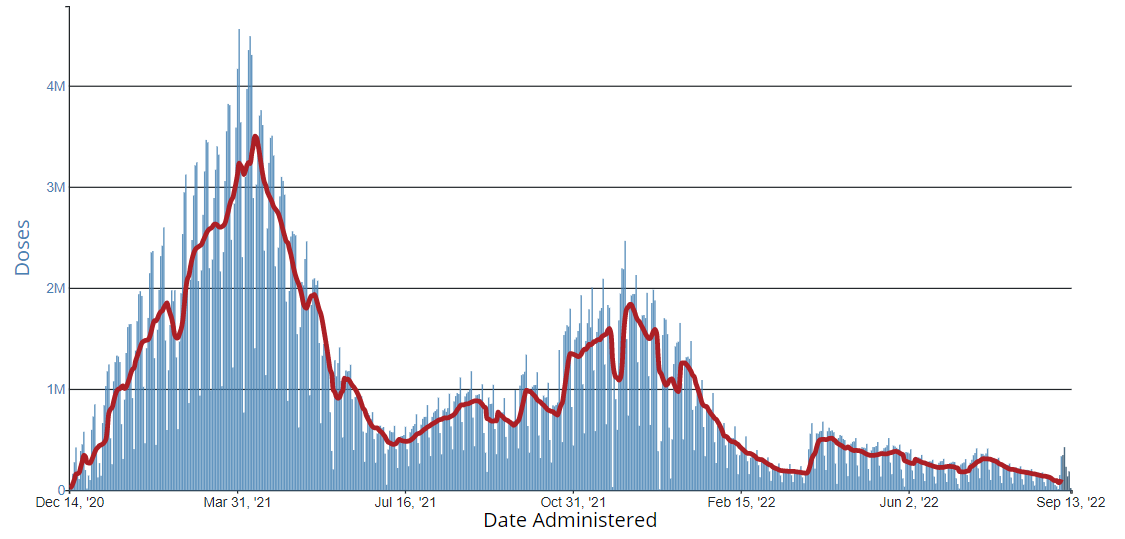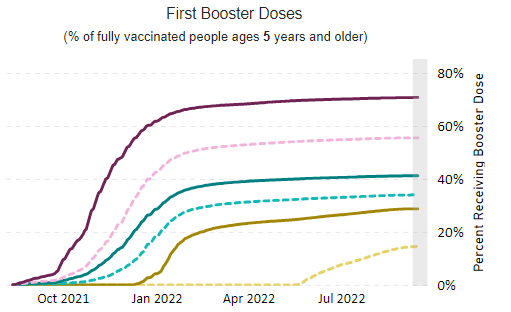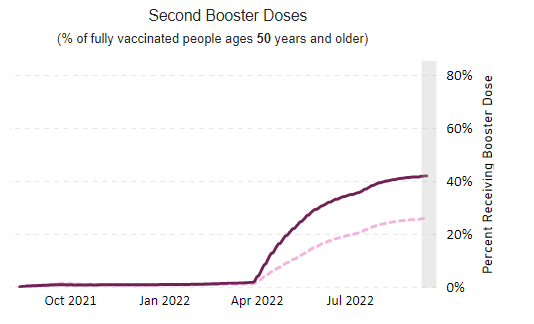Recommendations for Fully Vaccinated People
COVID-19 Homepage
Make Mine a Double
Interpretive Summary for September 16, 2022

Make Mine a Double
Both COVID-19 and flu vaccines have been shown to reduce illness, hospitalizations, and deaths. As flu season approaches and COVID-19 vaccine recommendations are updated, you might be wondering if you need to wait after getting a flu vaccine before getting a COVID-19 vaccine? The answer is “no!” You can get them both at the same time if you are eligible and the timing works. Experience with other vaccines has shown that immune response (the way our bodies develop protection) and possible side effects are generally the same whether you get one vaccine at a time or two.
Even though both vaccines can be given at the same visit, you should follow the recommended schedule for either vaccine: If you haven’t gotten your currently recommended doses of COVID-19 vaccine, get them as soon as you can, and ideally get a flu vaccine by the end of October. The same holds true for kids. If your child is eligible, they can get both vaccines at the same time, but don’t delay either vaccination in order to get them both at the same visit.
A recent CDC studyExternal suggests people who received a flu vaccine and an mRNA COVID-19 booster at the same time were slightly more likely (8% to 11%) to report reactions like fatigue, headache, and muscle ache than people who received only the COVID-19 booster, but these reactions were mostly mild and resolved quickly. If you have concerns about getting both vaccines at the same time, speak with your healthcare provider.
Note to readers: For more information, see Frequently Asked Questions about COVID-19 Vaccination and Frequently Asked Questions about Influenza: 2022-2023.
- Detection of Higher Cycle Threshold Values in Culturable SARS-CoV-2 Omicron BA.1 Sublineage Compared with Pre-Omicron Variant Specimens — San Francisco Bay Area, California, July 2021—March 2022
- Mortality Risk Among Patients Hospitalized Primarily for COVID-19 During the Omicron and Delta Variant Pandemic Periods — United States, April 2020–June 2022
COVID-19 Community Levels
As of September 15, 2022, there are 439 (13.6%) counties, districts, or territories with a high COVID-19 Community Level, 1,154 (35.8%) counties with a medium Community Level, and 1,627 (50.5%) counties with a low Community Level. Compared with last week, this represents a moderate decrease (−3.9 percentage points) in the number of high-level counties, a moderate decrease (-3.8 percentage points) in the number of medium-level counties, and a large increase (+7.4 percentage points) in the number of low-level counties. Overall, 46 out of 52 jurisdictions* had high- or medium-level counties this week. The District of Columbia, Hawaii, Nevada, New Mexico, Rhode Island, and Utah are the only jurisdictions to have all counties at low Community Levels.
To check your COVID-19 Community Level, visit COVID Data Tracker. To learn which prevention measures are recommended based on your COVID-19 Community Level, visit COVID-19 Community Level and COVID-19 Prevention.
*Includes the 50 states, the District of Columbia, and U.S. territories.
Reported Cases
As of September 14, 2022, the current 7-day moving average of daily new cases (59,856) decreased 15.9% compared with the previous 7-day moving average (71,190). A total of 95,314,517 COVID-19 cases have been reported in the United States as of September 14, 2022.
Variant Proportions
CDC Nowcast projections* for the week ending September 17, 2022, estimate that the combined national proportion of lineages designated as Omicron will continue to be 100%. There are five lineages designated as Omicron: BA.5, BA.4.6, BA.4, BF.7, and BA.2.75. UPDATE: BF.7 has been separated from BA.5 and BA.2.75 sublineage is separated from BA.2 due to their positive growth rate. Until last week, these were aggregated with BA.5 and BA.2, respectively. The predominant Omicron lineage is BA.5, projected at 84.8% (95% PI 83.2-86.3%).
The national proportion of BA.4.6 is projected to be 10.3% (95% PI 9.1-11.7%), BA.4 is projected to be 1.8% (95% PI 1.6-1.9%), BF.7 is projected to be 1.7% (95% PI 1.2-2.4%), and BA.2.75 is projected to be 1.3% (95% PI 0.8-2.2%). See COVID Data Tracker for current data.
95,314,517
Total Cases Reported
59,856
Current 7-Day Average**
71,190
Previous 7-Day Average
-15.9%
Change in 7-Day Average since Previous Week
*CDC uses Nowcast projections to predict current variant proportions circulating in the United States. The median time from specimen collection to sequence data reporting is about 3 weeks. As a result, weighted estimates for the most recent few weeks may be unstable or unavailable. View Nowcast estimates on CDC’s COVID Data Tracker website on the Variant Proportions page.
**Historical cases are excluded from daily new cases and 7-day average calculations until they are incorporated into the dataset for the applicable date. Of 658,910 historical cases reported retroactively, 8 were reported in the current week and none were reported in the prior week.
Vaccinations
COVID-19 Vaccine Primary Series
As of September 14, 2022, 612.8 million vaccine doses have been administered in the United States. Overall, about 263.4 million people, or 79.3% of the total U.S. population, have received at least one dose of vaccine. About 224.6 million people, or 67.7% of the total U.S. population, have been fully vaccinated.*
612,781,120
Vaccine Doses Administered
263,415,633
People who received at least one dose (79.3% of the U.S. population)
224,636,858
People who are fully vaccinated* (67.7% of the U.S. population)
+0.1
Percentage point increase from last week
+0.1
Percentage point change from last week
*Represents the number of people who have received the second dose in a two-dose COVID-19 vaccine series (such as the Pfizer-BioNTech, Moderna, or Novavax vaccines) or one dose of the single-shot Johnson & Johnson’s Janssen vaccine.
COVID-19 Vaccine Boosters
Of those fully vaccinated, about 109.2 million people have received a booster dose,* but 50.0% of the total booster-eligible population has not yet received a booster dose. Booster dose eligibility varies by age and health condition. Learn more about who is eligible.
133,366,571
Booster Doses Administered
109,199,336
Population ≥ 5 Years of Age with a 1st booster dose*
22,495,442
Population ≥ 50 Years of Age with a 2nd booster dose**
48.7%
Percentage of the Population ≥ 5 Years of Age with a 1st booster dose
34.7%
Percentage of the Population ≥ 50 Years of Age with a 2nd booster dose
+0.1
Percentage point increase from last week
+0.4
Percentage point increase from last week
*Represents the number of people who are fully vaccinated and have received another dose of COVID-19 vaccine since August 13, 2021. This includes people who received their first additional dose or booster dose.
**Represents the number of people who are fully vaccinated and have received two subsequent doses of COVID-19 vaccine since August 13, 2021. This includes people who received two booster doses and people who received one additional dose and one booster dose.
5,298,500
Total New Admissions
4,371
Current 7-Day Average
4,657
Prior 7-Day Average
-6.1%
Change in 7-Day Average
The start of consistent reporting of hospital admissions data was August 1, 2020.
Daily Trends in Number of New COVID-19 Hospital Admissions in the United States
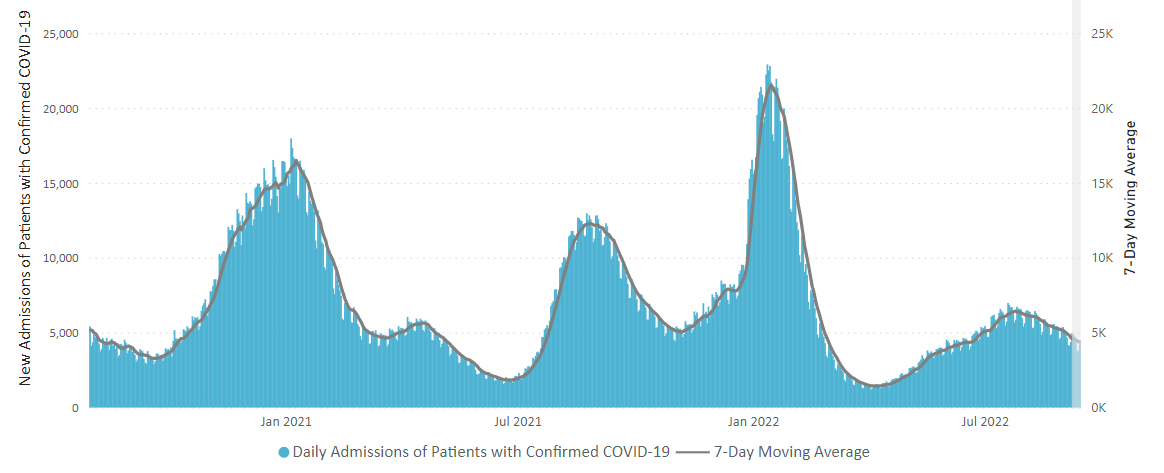
New admissions are pulled from a 10 am EDT snapshot of the HHS Unified Hospital Data – Analytic Dataset. Due to potential reporting delays, data from the most recent 7 days, as noted in the figure above with the grey bar, should be interpreted with caution. Small shifts in historic data may also occur due to changes in the Centers for Medicare & Medicaid Services (CMS) Provider of Services file, which is used to identify the cohort of included hospitals.
COVID-NET: Hospitalization Rates among Children Ages 6 Months and Younger
CDC’s Coronavirus Disease 2019-Associated Hospitalization Surveillance Network (COVID-NET) shows that for the week ending August 27, the rate of COVID-19-associated hospitalizations for children ages 6 months and younger, who are not eligible for vaccination, is 19.5 per 100,000 population. While rates among children ages 6 months and younger have generally declined in recent weeks, they are the highest among all pediatric age groups and remain high compared with many previous months of the pandemic.
Hospitalization Rates among Children Ages 6 Months and Younger
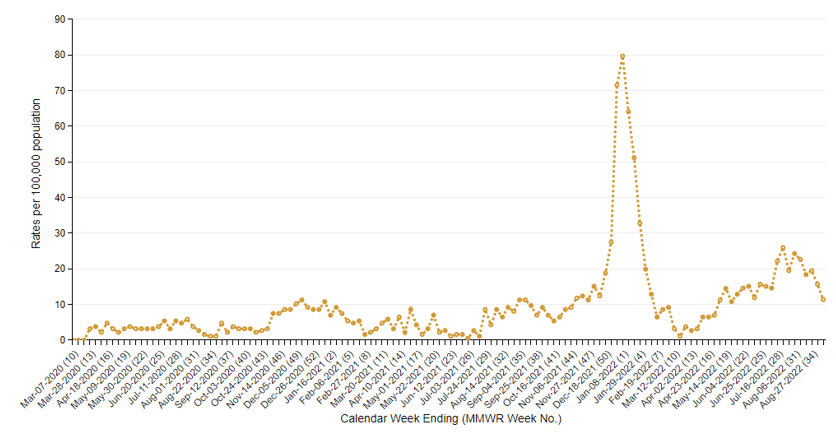
The Coronavirus Disease 2019 (COVID-19)-Associated Hospitalization Surveillance Network (COVID-NET) is an additional source for hospitalization data collected through a network of more than 250 acute-care hospitals in 14 states (representing ~10% of the U.S. population). Detailed data on patient demographics, including race/ethnicity, underlying medical conditions, medical interventions, and clinical outcomes, are collected using a standardized case reporting form.
Deaths
The current 7-day moving average of new deaths (358) increased 3.9% compared with the previous 7-day moving average (344). As of September 14, 2022, a total of 1,047,020 COVID-19 deaths have been reported in the United States.
1,047,020
Total Deaths Reported
358
Current 7-Day Average*
344
Prior 7-Day Average
3.9%
Change in 7-Day Average Since Prior Week
*Historical deaths are excluded from the daily new deaths and 7-day average calculations until they are incorporated into the dataset by their applicable date. Of 21,915 historical deaths reported retroactively, 41 were reported in the current week; and 27 were reported in the prior week.
Daily Trends in Number of COVID-19 Deaths in the United States Reported to CDC

7-Day moving average
 More Death Data
More Death DataTesting
The percentage of COVID-19 NAATs (nucleic acid amplification tests)* that are positive is decreasing in comparison to the previous week. The 7-day average of percent positivity from NAATs is now 12.2%. The 7-day average number of tests reported for September 2-September 8, 2022, was 395,481, down 22.0% from 507,235 for the prior 7 days.
955,004,672
Total Tests Reported
395,481
7-Day Average Tests Reported
12.2%
7-Day Average % Positivity
12.4%
Previous 7-Day Average % Positivity
-0.25
Percentage point change in 7-Day Average % Positivity since Prior Week
*Test for SARS-CoV-2, the virus that causes COVID-19
Wastewater Surveillance
COVID Data Tracker’s Wastewater Surveillance tab tracks levels, changes, and detections of SARS-CoV-2* viral RNA in wastewater at over 1,000 testing sites across the country.
Currently, most of the country is reporting moderate to high SARS-CoV-2 levels in wastewater. About 23% of sites reporting wastewater data are currently seeing some of the highest levels for those sites since December 1, 2021. About 43% of sites are experiencing a decrease in SARS-CoV-2 levels, and about 48% are reporting an increase. It’s important to note that even a small increase when levels are low can appear like a dramatic increase in the percent change.
For more information on how to use wastewater data, visit CDC’s website.
*The virus that causes COVID-19
SARS-CoV-2 Levels in Wastewater by Site
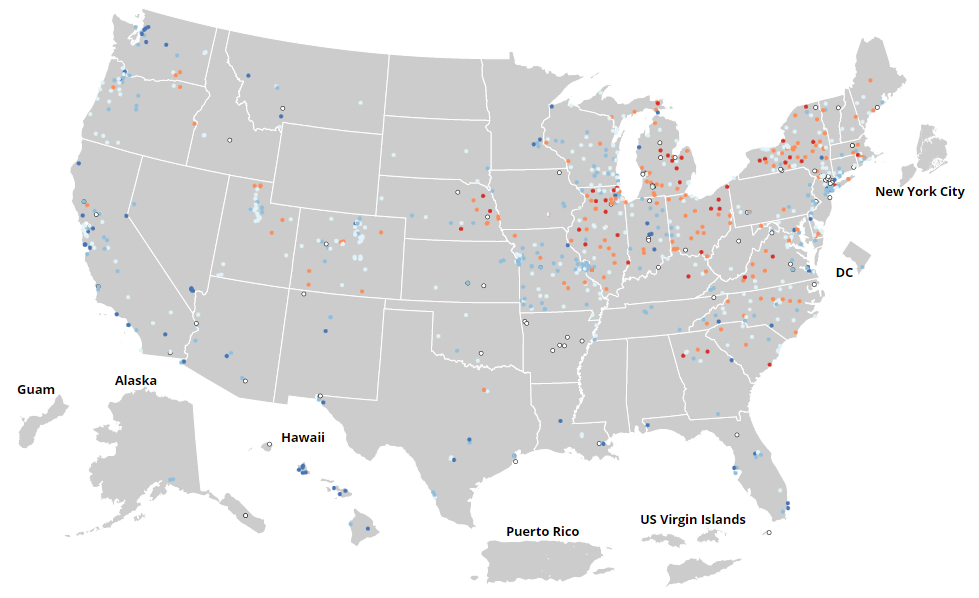

0% means levels are the lowest they have been at the site; 100% means levels are the highest they have been at the site.




